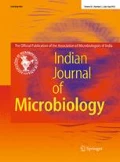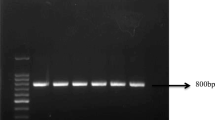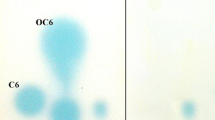Abstract
Edwardsiella ictaluri is a Gram-negative pathogenic bacterium in the family Enterobacteriaceae that causes enteric septicemia of catfish, which has become a significant problem in the aquaculture of striped catfish (Pangasianodon hypophthalmus) in Vietnam. In this study, a bacterium designated as Ei-151 was isolated from diseased striped catfish and proved to be virulent. Based on 16S rDNA sequencing and phenotypic tests, the pathogenic bacterium was identified as Edw. ictaluri. The presence of quorum sensing signal molecules in Edw. ictaluri Ei-151 was detected with different biosensor strains. The results showed that Ei-151 produced at least three kinds of acylated homoserine lactone (AHL) signal molecules as detected with the biosensor Agrobacterium tumefaciens KYC55, and the AHLs fingerprint was similar to that of Edw. tarda. During its entire growth, the levels of AHLs and autoinducer-2 produced by Ei-151 peaked at the stationary phase (OD600 1.8), which suggested that both of them may function at the stationary phase. No Cholerae autoinducer-1-like activity (including Edw. ictaluri LMG7860T) was detected.




Similar content being viewed by others
References
Panangala VS, Shoemaker CA, Klesius PH, Mitra A, Russo R (2009) Cross-protection elicited in channel catfish (Ictalurus punctatus Rafinesque) immunized with a low dose of virulent Edwardsiella ictaluri strains. Aquac Res 40:915–926
USDA (2003) Part II: reference of foodsize catfish health and production practices in the United States, USDA. N.A.H.M.S, Fort Collins
Fuqua WC, Winans SC, Greenberg EP (1994) Quorum sensing in bacteria: the LuxR–LuxI family of cell density-responsive transcriptional regulators. J Bacteriol 176(2):269–275
Irie Y, Parsek MR (2008) Quorum sensing and microbial biofilms. Curr Top Microbiol Immunol 322:67–84
Higgins DA, Pomianek ME, Kraml CM, Taylor RK, Semmelhack MF, Bassler BL (2007) The major Vibrio cholerae autoinducer and its role in virulence factor production. Nature 450:883–886
Defoirdt T, Verstraete W, Bossier P (2008) Luminescence, virulence and quorum sensing signal production by pathogenic Vibrio campbellii and Vibrio harveyi isolates. J Appl Microbiol 104:1480–1487
Kleerebezem M (2004) Quorum sensing control of lantibiotic production; nisin and subtilin autoregulate their own biosynthesis. Peptides 25:1405–1414
Lazazzera BA (2000) Quorum sensing and starvation: signals for entry into stationary phase. Curr Opin Microbiol 3:177–182
Waters CM, Bassler BL (2005) Quorum sensing: cell-to-cell communication in bacteria. Annu Rev Cell Dev Biol 21:319–346
Chen X, Schauder S, Potier N, Van Dorssealaer A, Pelczer I, Bassler BL, Hughson FM (2002) Structural identification of a bacterial quorum-sensing signal containing boron. Nature 415:545–549
Han Y, Li X, Qi ZZ, Zhang XH, Bossier P (2010) Detection of different quorum-sensing signal molecules in a virulent Edwardsiella tarda strain LTB-4. J Appl Microbiol 108(1):139–147
Zhang M, Sun K, Sun L (2008) Regulation of autoinducer 2 production and luxS expression in a pathogenic Edwardsiella tarda strain. Microbiology 154:2060–2069
Tempe J, Petit A, Holsters M, Mon Atagu MV, Schell J (1977) Thermosensitive step associated with transfer of the Ti Plasmid during conjugation: possible relation to transformation in crown gall. Proc Natl Acad Sci USA 74:2848–2849
Greenberg EP, Hastings JW, Ulitzur S (1979) Induction of luciferase synthesis in Beneckea harveyi by other marine bacteria. Arch Microbiol 120:87–91
Reed LJ, Muench S (1938) A simple method of estimating fifty percent and point. Am J Hyg 27:493–497
Lan J, Zhang XH, Wang Y, Chen J, Han Y (2008) Isolation of an unusual strain of Edwardsiella tarda from turbot and establish a PCR detection technique with the gyrB gene. J Appl Microbiol 105:644–651
Garrity GM (2005) Bergey’s manual of systematic bacteriology, vol 2, 2nd edn. Springer, New York
Zhu J, Chai Y, Zhong Z, Li S, Winans SC (2003) Agrobacterium bioassay strain for ultrasensitive detection of N-acylhomoserine lactone-type quorum-sensing molecules: detection of autoinducers in Mesorhizobium huakuii. Appl Environ Microbiol 69:6949–6953
Vilchez R, Lemme A, Thiel V, Schulz S, Sztajer H, Wagner DI (2007) Analysing traces of autoinducer-2 requires standardization of the Vibrio harveyi bioassay. Anal Bioanal Chem 387:489–496
Panangala VS, Shoemaker CA, McNulty ST, Arias CR, Klesius PH (2006) Intra- and interspecific phenotypic characteristics of fish-pathogenic Edwardsiella ictaluri and E. tarda. Aquac Res 37:49–60
Pesci EC, Iglewski BH (1997) The chain of command in Pseudomonas quorum sensing. Trends Microbiol 5:132–135
You Z, Fukushima J, Tanaka K, Kawamoto S, Okuda K (1998) Induction of entry into the stationary growth phase in Pseudomonas by N-acylhomoserine lactone. FEMS Microbiol Lett 164:99–106
Kalia VC, Raju SC, Purohit HJ (2011) Genomic analysis reveals versatile organisms for quorum quenching enzymes: acyl-homoserine lactone- acylase and -lactonase. Open Microbiol J 5:1–13
Huma N, Shankar P, Kushwah J, Bhushan A, Joshi J, Mukherjee T, Raju SC, Purohit HJ, Kalia VC (2011) Diversity and polymorphism in AHL-lactonase gene (aiiA) of Bacillus. J Microbiol Biotechnol 21:1001–1011
Kalia VC, Purohit HJ (2011) Quenching the quorum sensing system: potential antibacterial drug targets. Crit Rev Microbiol 37:121–140
Vendeville A, Winzer K, Heurlier K, Tang CM, Hardie KR (2005) Making ‘sense’ of metabolism: autoinducer-2, LuxS and pathogenic bacteria. Nat Rev Microbiol 3:383–396
Lombardía E, Rovetto AJ, Arabolaza AL, Grau RR (2006) A LuxS-dependent cell-to-cell language regulates social behavior and development in Bacillus subtilis. J Bacteriol 188:4442–4452
Henke JM, Bassler BL (2004) Three parallel quorumsensing systems regulate gene expression in Vibrio harveyi. J Bacteriol 186:6902–6914
Acknowledgments
The work was supported by grants from the National Natural Science Foundation of China (No. 31072241).
Author information
Authors and Affiliations
Corresponding author
Electronic supplementary material
Below is the link to the electronic supplementary material.
Rights and permissions
About this article
Cite this article
Yang, Q., Han, Y., Tinh, N.T.N. et al. Detection of Quorum Sensing Signal Molecules in Edwardsiella ictaluri Ei-151. Indian J Microbiol 52, 581–586 (2012). https://doi.org/10.1007/s12088-012-0312-9
Received:
Accepted:
Published:
Issue Date:
DOI: https://doi.org/10.1007/s12088-012-0312-9




